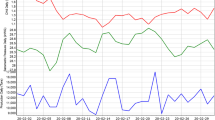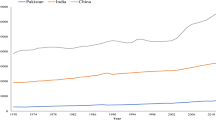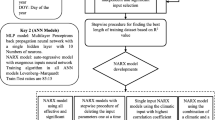Abstract
Methane gas is emitted during both underground and surface coal mining. Underground coal mines need to monitor methane gas emissions to ensure adequate ventilation is provided to guarantee that methane concentrations remain low under different production and environmental conditions. Prediction of methane concentrations in underground mines can also contribute towards the successful management of methane gas emissions. The main objective of this research is to develop a forecasting methodology for methane gas emissions based on time series analysis. Methane time series data were retrieved from atmospheric monitoring systems (AMS) of three underground coal mines in the USA. The AMS data were stored and pre-processed using an Atmospheric Monitoring Analysis and Database Management system. Furthermore, different statistical dependence measures such as cross-correlation, autocorrelation, cross-covariance, and variograms were implemented to investigate the potential autocorrelations of methane gas as well as its association with auxiliary variables (barometric pressure and coal production). The autoregressive integrated moving average (ARIMA) time series model which is based on auto-correlations of the methane gas is investigated. It is established that ARIMA used in the one-step-ahead forecasting mode provides accurate estimates that match the direction (increase/decrease) of the methane gas emission data.

















Similar content being viewed by others
References
Chaulya SK, Prasad GM (2016) Sensing and monitoring technologies for mines and hazardous areas, 1st (ed). Amsterdam, Netherlands.
Byrer C, Havryluk I, Uhrin D (2014) Coalbed methane: a miner’s curse and a valuable resource. In: Pramod T, Schatzel S, Aminian K (eds) Coalbed methane: from prospect to pipeline, 1st edn. Elsevier, Amsterdam, pp 1–6
Flores RM (1998) Coalbed methane: From hazard to resource. Int J Coal Geol. https://doi.org/10.1016/S0166-5162(97)00043-8
Kowalski-Trakofler DW, Alexander KM, McWilliams LJ, Reissman DB (2009) Underground coal mining disasters and fatalities-Unites States, 1900–2006. MMWR vol. 57:1379–1382. https://www.cdc.gov/mmwr/preview/mmwrhtml/mm5751a3.htm. Accessed November 02, 2021
The National Institute for Occupational Safety and Health (NIOSH) (2020) NIOSH data and statistics. https://wwwn.cdc.gov/NIOSH-Mining/MMWC/MineDisasters/Count. Accessed November 02, 2021
Kozlov P (2021) Russian coal mine: dozens killed in Siberia accident, BBC News. https://www.bbc.com/news/world-europe-59421319. Accessed December 01, 2021.
La República (2021) Doce muertos dejó una explosión en mina de carbón en Boyacá, a 190 km de Bogotá. Diario La República. https://www.larepublica.co/economia/doce-muertos-dejo-una-explosion-en-mina-de-carbon-en-boyaca-a-190-km-de-bogota-3222133. Accessed December 01, 2021
Düzgün HS, Leveson N (2018) Analysis of soma mine disaster using causal analysis based on systems theory (CAST). Saf Sci. https://doi.org/10.1016/j.ssci.2018.07.028
Yule UG (1927) On a method of investigating periodicities in disturbed series, with special reference to Wolfer’s Sunspot Numbers. Philos Trans R Soc London 226:167–298
Tsay RS (2000) Time series and forecasting: Brief history and future research. J Am Stat Assoc. https://doi.org/10.1080/01621459.2000.10474241
Nielsen A (2019) Practical time series analysis. Prediction with statistics & machine learning preview edition, 1st (ed). O'Reilly Media Inc. San Francisco, United States.
Box GEP, Jenkins GM, Reinsel GC, Ljung GM (2015) Time series analysis forecasting and control, 5th (ed). John Wiley & Sons. New Jersey, United States
Brockwell PJ, Davis RA (2016) Introduction to time series and forecasting, 3rd (ed). Springer. Switzerland
Cryer JD, Chan KS (2008) time series analysis with applications in R, 2nd (ed). Springer. New York, United States
Harkness T (2020) John Graunt at 400. J. Royal Statistical Society, Fighting disease with Numbers. https://doi.org/10.1111/1740-9713.01421
Astudillo G, Carrasco R, Fernández-Campusano C, Chacon M (2020) Copper price prediction using support vector regression technique Appl. Sci. https://doi.org/10.3390/app10196648
Tapia Cortez CA, Saydam S, Coulton J, Sammut C (2018) Alternative techniques for forecasting mineral commodity prices. Int. J. Min. Sci. Technol. https://doi.org/10.1016/j.ijmst.2017.09.001
Olayiwola A (2016) Forecasting copper spot prices: a knowledge-discovery approach. Dissertation, The University of Manchester, United Kingdom
Watari T, Nansai K, Nakajima K (2020) Major metals demand, supply, and environmental impacts to 2100: A critical review. Resour Conserv Recycl. https://doi.org/10.1016/j.resconrec.2020.105107
Rosienkiewicz M, Chlebus E, Detyna J (2017) A hybrid spares demand forecasting method dedicated to the mining industry. Appl Math Model. https://doi.org/10.1016/j.apm.2017.04.027
Renner S, Wellmer FW 2020 Volatility drivers on the metal market and exposure of producing countries. Miner. Econ. https://doi.org/10.1007/s13563-019-00200-8
Rodríguez SP 2020 Modeling and forecasting complex patterns of mineral production. Gold mining in Canada. Cogent Eng. https://doi.org/10.1080/23311916.2020.1724849
Gupta N, Tran D, Devegowda V, Jayaran C, Rai C, Sondergeld C, Karami H (2020) Looking ahead of the bit using surface drilling and petrophysical data: machine-learning-based real-time geosteering involve field. SPE J. https://doi.org/10.2118/199882-PA
Esmael B, Arnaout A, Fruhwirth RK, Thonhauser G (2013) A Statistical feature-based approach for operations recognition in drilling time series. Int J Comput Inf Syst Ind Manag Appl 5:454–461
Dixon DW (1992) A statistical analysis of monitored data for methane prediction. Dissertation, University of Nottingham. Nottingham, United Kingdom
Dixon DW, Longson I (1993) Statistical method for methane prediction and improved environmental control. In: Proceedings of the 6th North American Mine Ventilation Symposium (NAMVS), pp. 94–98. Salt Lake City, Utah, United States
Trutwin W, Wasilewski S (1987) Application of digital filter and time series analysis in ventilation control systems. In: Proceedings of the 5th North American Mine Ventilation Symposium (NAMVS), pp. 534–540. Morgantown, West Virginia, United States
Karacan CÖ, Diamond WP, Esterhuizen GS, Schatzel SJ (2005) Numerical analysis of the impact of longwall panel width on methane emissions and performance of gob gas ventholes. National Institute for Occupational Safety and Health (NIOSH). https://www.cdc.gov/niosh/mining/UserFiles/works/pdfs/naotio.pdf. Accessed 1 Oct 2021.
Griffin R, Jong EC, Luxbacher KD, Westman EC (2011) A review of atmospheric monitoring systems in underground coal mines: implications for explosion prevention. In: Proceedings for the Society for Mining, Metallurgy, and Exploration (SME), Preprint 11–127, pp. 683–686. Denver, Colorado, United States
Diaz J, Agioutantis Z, Hristopulos DT, Schafrik S (2021) Managing and utilizing big data in atmospheric monitoring systems for underground coal mines. Mater.Proc. 2021.https://doi.org/10.3390/materproc2021005078
Owili-Eger A, Stefanko S, Ramani RV (1973) Simulation of quantity and quality control in mine ventilation. Special Research Report SR-95. The Pennsylvania State University. Pennsylvania, United States
Sung W, Ertekin T, Ramani RV (1987) Evaluation of the impact of the degasification process on the inflow of methane gas into coal mines: a numerical exercise. In: Proceedings of the Society for Mining, Metallurgy & Exploration (SME), pp. 328–333. The United States of America
Booth P, Brown H, Nemcik J, Ting R (2017) Spatial context in the calculation of gas emissions for underground coal mines. Int. J. Min. Sci. Technol. https://doi.org/10.1016/j.ijmst.2017.07.007
Shumway RH, Stoffer DS (2017) Time series analysis and its applications, 4th (ed). Springer International Publishing. Cham, Switzerland
Tominaga Y, Bandopadhyay S 2002 Monitoring of spontaneous combustion based on time series data. In Proceedings of the 9th North American Mine Ventilation Symposium. https://doi.org/10.1201/9781439833742.ch48
Cao S, Liu Y, Wang Y (2008) A forecasting and forewarning model for methane hazard in working face of coal mine based on LS-SVM. J China Univ Min Technol. https://doi.org/10.1016/S1006-1266(08)60037-1
Shengrui Z, Baisheng N, Shuiwen L, Hui W, Qian L, Hailong L (2011) Model of gas concentration forecast based on chaos theory. Procedia Eng. https://doi.org/10.1016/j.proeng.2011.11.2160
Jorgensen S, Fath B (2019) Chaos. Encycl. Ecol. https://doi.org/10.1016/B978-008045405-4.00148-8
Zagorecki A (2015) Application of sensor fusion and data mining for prediction of methane concentration in coal mines. Mining-Informatics, Automation, and Electrical Engineering ed. vol. 53, nr 4, pp. 33–38
Taylor C, Karacan CÖ (2010) Historical development of technologies for controlling methane in underground coal mines. In: Extracting the Science: a century of mining research. Brune JF (ed), Littleton, CO, Pittsburgh, United States.
Goodman GVR, Karacan CÖ, Schatzel SJ, Krog RB, Taylor CD, Thimons ED (2008) NIOSH Research for monitoring and controlling methane at US, underground coal mining operations. In: Proceedings of the 21st World Mining Congress. pp. 291–299, Krakow, Poland
AMR PEMCO (2002) Multi-Gas Monitor. https://www.amrpemco.com/mc-6410-multi-gas-monitor/. Accessed October 10, 2021
Grimberg F, Asprion PM, Schneider B, Miho E, Babrak L, Habbabeh A 2021 the real-world data challenges radar: a review on the challenges and risks regarding the use of real-world data. Digit. Biomarkers, https://doi.org/10.1159/000516178
Verma U (2019) Data cleaning and pre-processing. Analytics Vidhya. https://medium.com/analytics-vidhya/data-cleaning-and-preprocessing-a4b751f4066f. Accessed November 02, 2021
Baur J, Moreno-Villanueva M, Kötter T, Sindlinger T, Bürkle A, Berthold N, Junk M (2015) MARK-AGE data management: cleaning, exploration and visualization of data. Mech Ageing Dev. https://doi.org/10.1016/j.mad.2015.05.007
Diaz J, Agioutantis Z, Schafrik S, Hristopulos DT (2021) Towards atmospheric monitoring data analysis in underground coal mines. In: Proceedings of the 18th North American Mine Ventilation Symposium (NAMVS). https://doi.org/10.1201/9781003188476-51
Griffin R (2013) Utilization and implementation of atmospheric monitoring systems in United States underground coal mines and application of risk assessment. Dissertation, The Virginia Polytechnic Institute, and State University. Virginia, United States
Zhou C, Damiano N, Whisner B, Reyes M (2017) Industrial Internet of Things (IIoT) applications in underground coal mines. Min. Eng. https://doi.org/10.19150/me.7919
Palshikar GK (2009) Simple algorithms for peak detection in time series. In: Proceedings of 1st International Conference on Advanced Data Analysis (IIMA), July 2009. Ahmedabad, Gujarat, India
El Yazidi A, Ramonet M, Ciais P, Broquet G, Pison I, Abbaris A, Brunner D, Conil S, Delmotte M, Gheusi F, Guerin F, Hazan L, Kachroudi N, Kouvarakis G, Mihalopoulos N, Rivier L, Serça, D (2018) Identification of spikes associated with local sources in continuous time series of atmospheric CO, CO2, and CH4. Atmos Meas Tech. https://doi.org/10.5194/amt-11-1599-2018
Goin DE, Ahern J (2019) Identification of spikes in time series. Epidemiol. Method. https://doi.org/10.1515/em-2018-0005
Vlachos M, Meek C, Vagena Z, Gunopulos D (2004) Identifying similarities, periodicities, and bursts for online search queries, In Proceedings of the 2004 ACM SIGMOD international conference on Management of Data – SIGMOD. https://doi.org/10.1145/1007568.1007586
Thomas S (2014) Basic Statistics, 1st (ed). Alpha Science International Ltd. Oxford, United Kingdon
Schober P, Boer C, Schwarte LA (2018) Correlation coefficients: appropriate use and interpretation. Anesth Analg. https://doi.org/10.1213/ANE.0000000000002864
Smith T (2021) Autocorrelation. https://www.investopedia.com/terms/a/autocorrelation.asp. Accessed December 04, 2021
National Institute of Standards and Technology (NIST) (2003) Engineering Statistics Handbook. https://www.itl.nist.gov/div898/handbook/. Accessed December 07, 2021
Hristopulos DT (2020) Random fields for spatial data modeling: a primer for scientists and engineers. Springer Nature, Dordrecht
Hyndman RJ, Athanasopoulos G (2021) Forecasting: principles and practice. https://otexts.com/fpp3/. Accessed January 10, 2022
Funding
This study was sponsored by the Alpha Foundation for the Improvement of Mine Safety and Health, Inc. (ALPHA FOUNDATION), contract number AFCTG20-103.
Author information
Authors and Affiliations
Contributions
Supervision, Z.A.; writing—original draft, J.D.; writing—review and editing, Z.A., D.H, S.S, KL. All authors have read and agreed to the published version of the manuscript.
Corresponding author
Ethics declarations
Ethics Approval
Not applicable.
Consent to Participate
Not applicable.
Conflict of Interest
The authors declare no competing interests.
Disclaimer
The views, opinions, and recommendations expressed herein are solely those of the authors and do not imply any endorsement by the ALPHA FOUNDATION, its Directors, and staff. The funders had no role in the design of the study, in the collection, analyses, or interpretation of data, in the writing of the manuscript, or in the decision to publish the results.
Additional information
Publisher's Note
Springer Nature remains neutral with regard to jurisdictional claims in published maps and institutional affiliations.
Rights and permissions
Springer Nature or its licensor holds exclusive rights to this article under a publishing agreement with the author(s) or other rightsholder(s); author self-archiving of the accepted manuscript version of this article is solely governed by the terms of such publishing agreement and applicable law.
About this article
Cite this article
Diaz, J., Agioutantis, Z., Hristopulos, D.T. et al. Time Series Modeling of Methane Gas in Underground Mines. Mining, Metallurgy & Exploration 39, 1961–1982 (2022). https://doi.org/10.1007/s42461-022-00654-5
Received:
Accepted:
Published:
Issue Date:
DOI: https://doi.org/10.1007/s42461-022-00654-5




